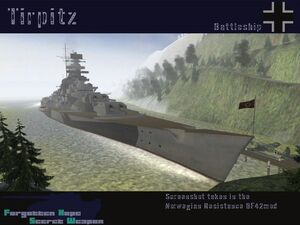| Tirpitz | |
|---|---|

| |
| General information | |
| Place of origin | Nazi Germany |
| Category | Battleship |
| Class | Bismarck Class |
| Sister ships | Bismarck Hindenburg |
| Used by | Germany |
| Speed | 30 knots (56 km/h; 35 mph) |
| Special abilities | Can be use as target on objective type. |

| |
Tirpitz was a 44,755 ton German battleship commissioned in 1941 (sister ship to the Bismarck) was named after the creator of the German High Seas Fleet, Grand Admiral Alfred von Tirpitz, and out of action for some six months following an attack by Royal Navy midget submarines.
She saw very limited action, spending almost the entire war in various bases in Norway, where her mere presence was a great threat to the Allies, tying up huge naval and air forces to make sure she could be dealt with if she ever made an offensive sortie. Due to her role and bases of operations, she was dubbed the "Lonely Queen of the North" by the Norwegians.
Only once during the war did the Tirpitz fire its huge 15-inch guns and that was in the bombardment of Spitzbergen in September, 1943, which destroyed the Allied base there.
On September 17, 1944, it was again attacked whilst holed up in Altenfjord in Norway. For this attack the Soviets co-operated by permitting the RAF to use their airfield at Yagodnik. Hit by one of the 13 ´Tallboy´ bombs dropped on the ship, the Tirpitz was damaged but not sunk.
The battleship was then moved south to Tromso and moored in Sorbotn off Hakoya Island. For the next attack on November 12th, the RAF dispatched 32 Lancaster bombers from 9 and 617 Squadrons based at Lossiemouth, Scotland.
Flying at 14,000 feet, they scored two direct hits with 12,000 pound ´Tallboy´ bombs tearing open her hull for a hundred feet. The Tirpitz turned completely over, her upperworks hitting the shallow bottom leaving her stuck there with only her red keel showing above the water.
Trapped inside were 971 crewmen who slowly died as the water rose inside. Only 76 men survived by making their way up to the bottom of the hull which was then cut open by rescue teams.
After the war, Tirpitz fragments were broken down and sold on the spot by the Norwegian company. Almost the entire ship was cut and removed. However, much of the bow of the Tirpitz remains where she sank in 1944.
| ||||||||||||||||||||||||||
| ||||||||||||||



